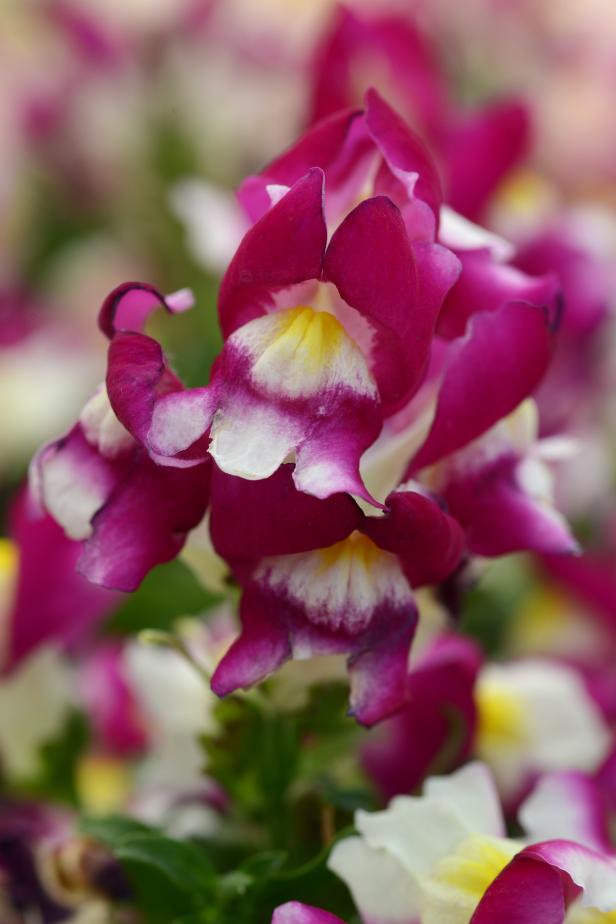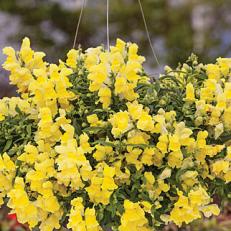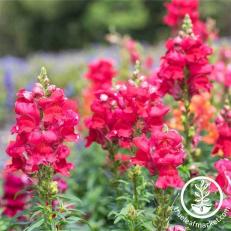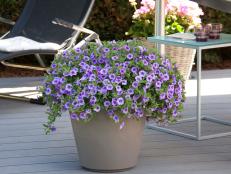How to Grow and Care for Snapdragon Flowers
Bring cottage garden charm to your yard with snapdragons, an old-fashioned favorite.

Snapdragons are an old-fashioned cottage garden flower that have been grown for generations. They produce clusters of bell-shaped flowers on a tall stalk. Name almost any color and there's a snapdragon variety that blooms in that hue: pink, red, lavender, white, orange, bicolor, speckled, maroon, salmon, magenta ... see what I mean?

PanAmerican Seed
Snapdragons come in a rainbow of bright colors, and bees love them.
Flowers can be singles, doubles, azalea-shaped or have open faces, and they can grow as tall as 4 feet or be as short as 6 inches. Snapdragons hit their peak in spring and early summer when temperatures are mild. They stop blooming in the heat of summer but with sufficient watering, they'll get a second wind and bloom again in the fall.
Snapdragons 101
Native to Europe, snapdragons have been grown domestically since the days of the Roman Empire. Their botanical name means "like a snout" but most people think snapdragons look like mouths, not noses. Back in your great-grandma's day when kids played outside, they would squeeze the sides of snapdragon flowers to make the petals open like a dragon's mouth, put their finger in the opening, stop squeezing the flower, and bang, the mouth would close on their finger. Then TV was invented and kids stopped sticking their fingers in flowers.
Snapdragons come in four basic varieties:
Trailing snapdragons grow vines up to 2 feet long and creep along the ground or pour over the sides of containers.
Dwarf snapdragons were developed in the 1930s for use in rock gardens and to edge flower beds. They grow 6 to 12 inches tall and form dense, bushy plants with lots of flower stalks.
Medium snapdragons grow 1 to 2 feet tall.
Tall snapdragons grow 2 to 4 feet in height. They're elegant and produce spikey wands of flowers that look fabulous in a border.
These classic favorites attract hummingbirds, bees and butterflies and make excellent cutting flowers. In most places, snapdragons are grown as cool-season annuals. They're biennials in USDA Zones 8 and 9. If you're lucky, they'll self-sow and you'll get volunteers the following year.
Botanical Name: Antirrhinum majus
Common Names: Snapdragon, dog's mouth, lion's mouth, toad's mouth
Bloom Time: Spring and fall
Light Needs: Full sun to partial shade
Hardiness Zones: 7 to 10
Planting Snapdragons
Plant snapdragons in full sun. You'll get the most blooms if your plants get at least 8 hours of sun a day.
Plant them early in cool weather. They don't like heat.
Get the soil right. Snapdragons like well-drained soil with a neutral pH between 6.2 and 7. They're short-lived plants, so they are not heavy feeders. But mixing organic matter into the soil where you plant them will keep them strong, healthy and full of flowers.
Most people start snapdragons from transplants bought at a nursery, or from seed started indoors 8 to 10 weeks before the last frost date. The reason? Snapdragons stop blooming when daytime highs hit the 80s, so their flower season is short. Depending on the USDA zone you live in, your growing season may not allow enough time to grow them from seed sown directly in the garden in the spring.
Pro Tip: For the prettiest, most old-fashioned varieties, start your snapdragons from seed. You can get heirloom varieties from seed companies, which look better than the garishly colored newer varieties that fill the shelves of garden centers.
Bee-Friendly Garden Flowers 25 Photos
Snapdragon attracts bees. See 24 other flowers and plants to include in a colorful, bee-friendly garden.
Caring for Snapdragons
Once they're established, give them 1 inch of water per week. Water at the roots of the plants. Overhead watering gets the leaves wet and can lead to mildew and other fungal diseases.
Mulch plants to keep down weeds and hold moisture in the soil. Once summer heat kicks in, mulch will help keep the roots cool and the plants healthy until they get their second wind in the fall and bloom again.
Clip off any leaves that look diseased as soon as you spot them. Snapdragons are prone to fungal diseases and powdery mildew.
Fertilize snapdragons as soon as they start producing flowers.
Stake taller varieties so they don't fall over under the weight of those stalks of flowers.
Prune spent blooms during the spring to keep the snapdragons blooming.
Cut them back in the dog days of summer and they'll bloom again when cool weather returns.
Pests and Problems
Snapdragons are affected by bacterial leaf spot, botrytis, damping off, powdery mildew and rust; and pests like aphids, cutworms, leaf miners, cyclamen mites and spider mites. The good news: deer and rabbits don't eat them.
Recommended Snapdragon Varieties
Plant breeders love playing with snapdragons, so new varietals emerge every year. Most are sold as multicolor blends of seeds or transplants, but you can sometimes find individual colors. Some of the more popular series include:
Trailing
'Candy Showers' produces cascades of blooms on 12- to 14-inch vines that look lovely streaming out of containers.
Dwarf
'Floral Showers' produces bicolor blooms in shades of apricot, coral, lavender, red, yellow and white on 8-inch tall plants.
'Twinny Peach' is a double-flowered beauty that produces mounds of pastel blooms on tiny plants. It's perfect for containers or the front of a mixed border.
Medium
'Tutti-Frutti' has brightly colored blooms in orange, yellow, pink and ivory specked and striped with contrasting hues.
'Cinderella Mix' features blooms in cream, yellow, gold, salmon, orange and scarlet on 20-inch tall plants. You get maximum flowers per plant with this type because after the main spike blooms, plants send out side shoots that make more blooms.
Tall
'Rocket' series snapdragons are more heat tolerant than other types so they're a good choice for warmer climates. These dependable, hardy plants produce blooms in a range of colors including red, yellow, white and pink.
'Madame Butterfly' produces ruffled, double-petal blooms that look a bit like rosebuds on 30 inch plants. Flowers come in a mix of colors including bronze, ivory, pink, rose, red and yellow. They are gorgeous as cut flowers.
'Topper' produces elegant spikes of flowers in yellow, salmon, scarlet and white on 3-foot tall plants.
Shop Snapdragon Seeds
Plants For Spring Color 13 Photos
Let your garden explode with color this spring when you plant a variety of flowering shrubs, bulbs and annuals.

.-Battle-on-the-Beach-courtesy-of-HGTV.-.jpg.rend.hgtvcom.196.196.suffix/1714761529029.jpeg)











.jpg.rend.hgtvcom.231.174.suffix/1716908436155.jpeg)






































